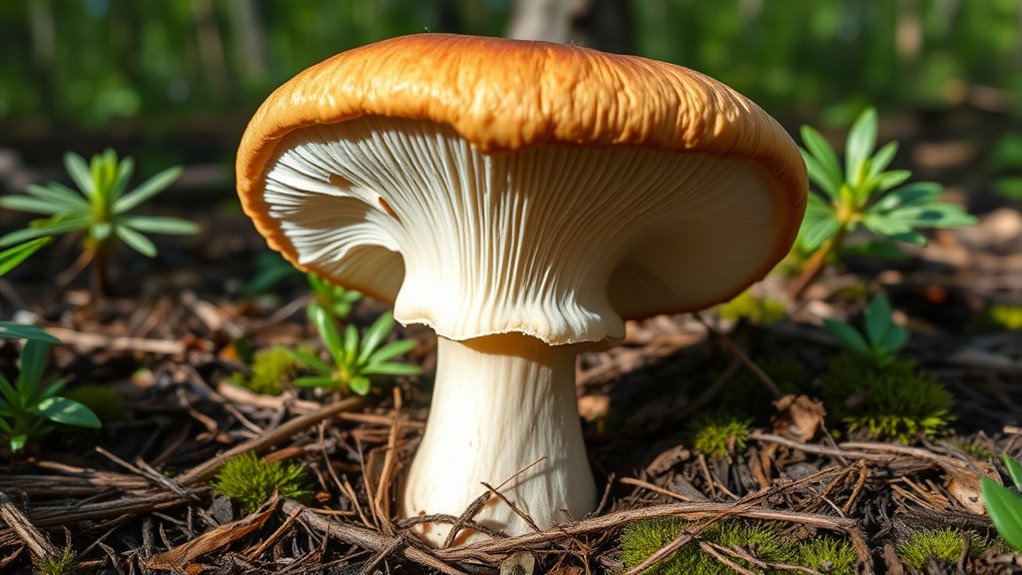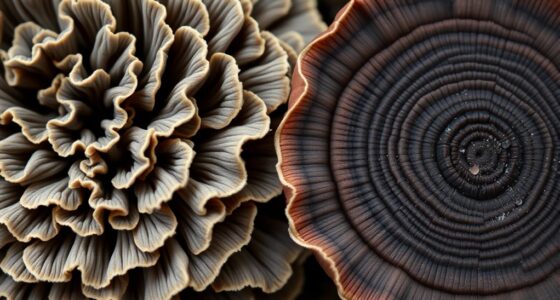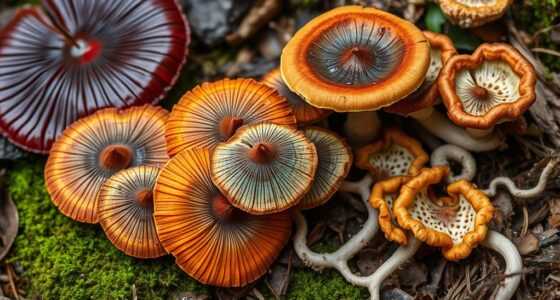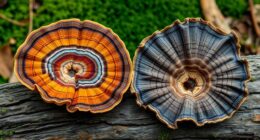To identify the king bolete, look for a thick, bulbous brown cap that’s convex and becomes flatter with age, with a velvety surface. Its stem is sturdy and bulbous, often with a reddish or brown hue. You’ll find it thriving near beech, pine, or fir trees after rain in rich, organic forest soil. Be sure to recognize its sponge-like pores underneath that turn white or yellowish when young. Keep in mind, proper identification is key—continue exploring to discover more about its safety and habitat.
Key Takeaways
- Recognize King Bolete by its thick, bulbous brown cap with velvety surface and white/yellowish sponge-like pores underneath.
- Find them in deciduous or coniferous forests, especially near beech, pine, or fir trees, after rain.
- Ensure correct identification by noting the cap’s color, pore surface, and habitat; avoid look-alikes.
- Handle mushrooms gently, clean thoroughly, and cook properly before consumption to ensure safety.
- Consult reliable field guides or experts for positive identification to prevent consuming toxic look-alikes.
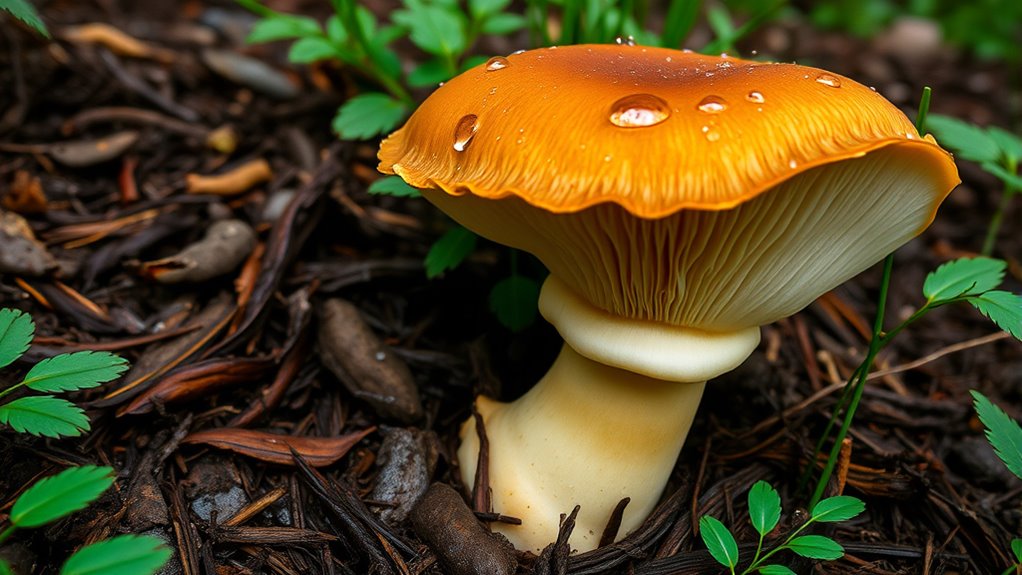
The King Bolete, also known as Porcini, is one of the most prized wild mushrooms for culinary enthusiasts. When you discover this mushroom, you hold a treasure that can elevate your cooking and access new flavors. Its rich, earthy aroma and meaty texture make it a versatile ingredient that can transform simple dishes into gourmet experiences. Whether you’re sautéing it with garlic, tossing it into risottos, or drying it for later use, the culinary uses of porcini are broad and satisfying. Its deep umami flavor adds complexity to any recipe, giving you the freedom to experiment and create with confidence. Plus, the nutritional benefits of porcini are impressive; packed with protein, fiber, vitamins, and minerals, it’s a nourishing addition that supports your health and wellbeing. Incorporating porcini into your diet isn’t just about taste—it’s about embracing a lifestyle of natural, wholesome eating.
As you hunt for porcini, you realize that identifying it correctly is key to enjoying its benefits safely. This mushroom’s thick, bulbous stem and the distinctive brown cap with a velvety surface are your first clues. The cap can range from light to dark brown, often with a slightly convex shape that flattens with age. Its gills are absent; instead, you’ll notice a sponge-like pore surface underneath, which is white to yellowish when young and darkens as it matures. Habitat is essential for proper identification—porcini flourish in deciduous and coniferous forests, especially near beech, pine, and fir trees. They often grow in clusters, popping up after rain and thriving in soil rich in organic matter. Always be cautious—mistaking porcini for toxic look-alikes can have serious consequences. A reliable field guide or expert consultation can help you distinguish the real deal from imposters, ensuring your foraging is both safe and rewarding. Additionally, understanding the bias to action in foraging can help you decide when to harvest or seek expert advice, improving your safety and success rate.
Once you’ve identified and collected your porcini, handling it properly is imperative. Clean the mushroom gently to preserve its delicate aroma and flavor. When you’re ready to cook, remember that its culinary uses are diverse—sauté, grill, dry, or incorporate into broths. Its nutritional benefits make it a powerhouse of health: high in antioxidants, low in calories, and rich in essential nutrients that support your immune system. Embracing porcini isn’t just about feeding your body; it’s about reclaiming your connection to nature’s bounty and making conscious choices about what you eat. By understanding how to identify, harvest, and prepare this mushroom, you take control of your culinary journey, opening flavors and health benefits that empower you to live more freely and fully.
Frequently Asked Questions
Can King Bolete Be Used in Medicinal Therapies?
Yes, you can use king boletes for medicinal purposes. Their medicinal properties are gaining attention for their potential therapeutic uses, like boosting immunity and reducing inflammation. You’re free to incorporate them into your diet or herbal remedies, harnessing their natural benefits. Trust in their healing qualities and explore how these mushrooms can support your health, offering a natural path to well-being and liberation from synthetic treatments.
How Long Does It Take to Cultivate King Bolete Commercially?
You can expect the cultivation timeline for King Bolete to take about 1 to 3 years, depending on your methods and environment. For commercial farming, patience is key, as it requires careful planning, proper substrate preparation, and ideal conditions. This process allows you to produce high-quality mushrooms while gaining independence from wild harvesting. With dedication and the right techniques, you’ll enjoy a steady, sustainable supply of King Bolete for years to come.
Are There Any Common Look-Alikes That Are Toxic?
Did you know that many mushroom poisonings occur due to mistaken look alikes? Some toxic varieties resemble the King Bolete closely, making look alike identification essential. Common look-alikes, like certain Suillus or Suillellus species, can cause severe poisoning if misidentified. To stay safe and enjoy foraging, always double-check distinctive features, avoid guessing, and consult expert guides. Your safety depends on accurate identification—don’t risk mushroom poisoning by overlooking these key differences.
What Is the Best Season for Harvesting King Bolete?
You should harvest king boletes during late summer to early fall, aligning with prime foraging seasons. Climate effects, like warm, rainy weather, boost their growth, so keep an eye on weather patterns. This window offers the best chance to find fresh, flavorful specimens. Embrace the freedom of foraging during these months; nature awakens, and with it, your opportunity to harvest these magnificent fungi.
Can King Bolete Be Preserved for Long-Term Storage?
Yes, you can preserve king bolete for long-term storage. Use preservation techniques like drying and freezing to maintain their flavor and texture. For drying, slice the mushrooms thinly and store in airtight containers in a cool, dark place. Freezing works well too—clean, blanch briefly, then store in vacuum-sealed bags. These storage methods let you enjoy your favorite mushrooms anytime, giving you the freedom to savor them long after harvest.
Conclusion
You now know how to identify and safely enjoy the king bolete. Imagine your first perfect harvest, feeling proud as you cook its rich, earthy flavor. But beware—misidentification can lead to dangerous mistakes. For example, a novice forager once mistook a toxic look-alike, ending up in the hospital. So, always double-check your finds, respect nature, and savor each mushroom responsibly. Your safe foraging journey starts now—happy hunting!

